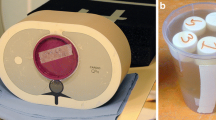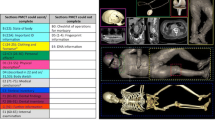Abstract
Objective
Detection of explosives is a challenge due to the use of improvised and concealed bombs. Post-bomb strike bodies are handled by emergency and forensic teams. We aimed to determine whether medical dual-energy computed tomography (DECT) algorithm and prediction model can readily detect and distinguish a range of explosives on the human body during disaster victim identification (DVI) processes of bombings.
Materials and Methods
A medical DECT of 8 explosives (Semtex, Pastex, Hexamethylene triperoxide diamine, Acetone peroxide, Nitrocellulose, Pentrite, Ammonium Nitrate, and classified explosive) was conducted ex-vivo and on an anthropomorphic phantom. Hounsfield unit (HU), electron density (ED), effective atomic number (Zeff), and dual energy index (DEI),were compared by Wilcoxon signed rank test. Intra-class (ICC) and Pearson correlation coefficients (r) were computed. Explosives classification was performed through a prediction model with test-retest samples.
Results
Except for DEI (p = 0.036), means of HU, ED, and Zeff were not statistically different (p > 0.05) between explosives ex-vivo and on the phantom (r > 0.80). Intra- and inter-reader ICC were good to excellent: 0.806 to 0.997 and 0.890, respectively. Except for the phantom DEI, all measurements from each individual explosive differed significantly. HU, ED, Zeff, and DEI differed depending on the type of explosive. Our decision tree provided Zeff and ED for explosives classification with high accuracy (83.7%) and excellent reliability (100%).
Conclusion
Our medical DECT algorithm and prediction model can readily detect and distinguish our range of explosives on the human body. This would avoid possible endangering of DVI staff.




Similar content being viewed by others
Abbreviations
- DVI:
-
Disaster victim identification
- Z eff :
-
Effective atomic number
- ED:
-
electron density
- DE:
-
Dual energy
- DEI:
-
Dual energy index
- EOD:
-
Explosive ordnance disposal office
- RANDO:
-
Radiation analog dosimetry
- TATP:
-
Triacetone triperoxide
- HMTD:
-
Hexamethylene triperoxide diamine
- ICC:
-
Intra-class coefficient
- CI:
-
Confidence interval
- DLP:
-
Dose length product
References
Singh S, Singh M (2003) Explosives detection systems (EDS) for aviation security. Signal Process 83:31–55
The Projected Al Qaeda Use of Body Cavity suicide bombs against high value targets. Homeland Security Resource Center. http://www.homelandsecurity.com/2011/04/11/the-projected-al-qaeda-use-of-body-cavity-suicide-bombs-against-high-value-targets. Published January 2011. Published Sep 3, 2018. Accessed Sep 30, 2018
Al-Qaida’s ‘Body Bombs’ increase fears of global attacks by master bomb-maker Ibrahim Hassan Tali al-Asiri. International Business Times UK. 2012. https://www.ibtimes.co.uk/al-qaida-s-body-bombs-increase-fears-340801. Published January 2012. Accessed Sep 30, 2018
Rutty GN, Alminyah A, Apostol M, Boel LW, Brough A, Bouwer H et al (2018) Positional statement radiology disaster victim identification reporting forms: positional statement of the members of the Disaster Victim Identification working group of the International Society of Forensic Radiology and Imaging; J Forensic Radiol Imaging. http://www.sciencedirect.com/science/article/pii/S2212478018300947. Accessed Oct 12, 2018
Schuliar Y (2012) Les morts judiciaires – le rôle de la Médecine Légale, Judicial deaths and the role of forensic medicine. The particular case of identifying the victims of catastrophes. Études Sur Mort 142:193–223
Chaudhary S, Ninsawat S, Nakamura T (2019 Jan) Non-destructive trace detection of explosives using pushbroom scanning hyperspectral imaging system. Sensors (Basel) 19(1):97
Maass C, Meyer E, Kachelriess M (2011) Exact dual energy material decomposition from inconsistent rays (MDIR). Med Phys 38(2):691–700
Mouton A, Breckon TP (2015) A review of automated image understanding within 3D baggage computed tomography security screening. J Xray Sci Technol 23(5):531–555
Qi Z, Zambelli J, Bevins N, Chen G-H (2010) Quantitative imaging of electron density and effective atomic number using phase contrast CT. Phys Med Biol 55(9):2669–2677
Gascho D, Zoelch N, Richter H, Buehlmann A, Wyss P, Schaerli S (2019) Identification of bullets based on their metallic components and X-ray attenuation characteristics at different energy levels on CT. AJR Am J Roentgenol 23:1–9
Hua C, Shapira N, Merchant TE, Klahr P, Yagil Y (2018) Accuracy of electron density, effective atomic number, and iodine concentration determination with a dual-layer dual-energy computed tomography system. Med Phys 45(6):2486–2497
Alvarez RE, Macovski A (1976) Energy-selective reconstructions in X-ray computerized tomography. Phys Med Biol 21(5):733–744
Naydenov SV, Ryzhikov VD, Smith CF (2004) Direct reconstruction of the effective atomic number of materials by the method of multi-energy radiography. Nucl Instrum Methods Phys Res Sect B Beam Interact Mater At. 215(3):552–560
Tatsugami F, Higaki T, Kiguchi M et al (2014) Measurement of electron density and effective atomic number by dual-energy scan using a 320-detector computed tomography scanner with raw data-based analysis: a phantom study. J Comput Assist Tomogr 38(6):824–827
Roele ED, Timmer VCMI, Vaassen LAA, Van Kroonenburgh AMJL (2017 March) Dual-energy CT in head and neck imaging. Curr Radiol Rep 5(5):19
Carlton RR, Adler AM (2012) Principles of radiographic imaging: An Art and A Science. Delmar (5):192–203
Lavrakas PJ (2008) Encyclopedia of survey research methods. Sage Publications, Inc, Thousand Oaks
Schober P, Boer C, Schwarte LA (2018) Correlation coefficients. Anesth Analg 126(5):1763–1768
Koo TK, Mae YL (2016) A guideline of selecting and reporting intraclass correlation coefficients for reliability research. J Chiropr Med 15:155–163
Megherbi N, Han J, Breckon TP, Flitton GT (2012) A comparison of classification approaches for threat detection in CT based baggage screening. In: 2012 19th IEEE International Conference on Image Processing. p 3109–12
Wiley D, Ghosh D, Woodhouse C (2012) Automatic segmentation of CT scans of checked baggage. Conference: Conference: 2nd International Meeting on Image Formation in X-ray CT
Flitton G, Breckon TP, Megherbi N (2013) A comparison of 3D interest point descriptors with application to airport baggage object detection in complex CT imagery. Pattern Recogn 46(9):2420–2436
Avi I (2010) Liquid explosives review. http://www.aiexplosives.com/. Accessed Oct 12, 2018
Limor M (2014) Enhanced information extraction in the multi-energy x-ray tomography for security https://open.bu.edu/handle/2144/11131. Accessed Oct 12, 2018
Materese R (2016) Data . NIST. https://www.nist.gov/data. Accessed Oct 23, 2018
Shrimpton PC (1981) Electron density values of various human tissues: in vitro Compton scatter measurements and calculated ranges. Phys Med Biol 26(5):907–911
Kane SA (2009) Introduction to Physics in modern medicine. Taylor & Francis. 449 p. Accessed Oct 12, 2018
Tatsugami F (2014) Electron density and effective atomic number images generated by dual energy imaging with a 320-detector CT system: a feasibility study https://posterng.netkey.at/esr/viewing/index.php?module=viewing_poster&task=viewsection&pi=121223&ti=402071&si=1382&searchkey. Accessed Jul 12, 2018.
Iovea M, Neagu M, Duliu OG et al (2007) High accuracy x-ray dual-energy experiments and non-rotational tomography algorithm for explosives detection technique in luggage control. In: Proc DIR
Marshall M, Oxley JC (2009) Chapter 1 - The detection problem. In: Marshall M, Oxley JC (eds) Aspects of explosives detection. Elsevier, Amsterdam, pp 1–10 http://www.sciencedirect.com/science/article/pii/B9780123745330000015. Accessed Oct 12, 2018
(1979) Explosives detection by dual-energy computed tomography (CT) | Roder | Publications | Spie. https://spie.org/Publications/Proceedings/Paper/10.1117/12.957385. Accessed Jul 26, 2018
Gounhalli SG, Shantappa A (2012) Studies on effective atomic numbers and electron densities of some chemical explosives in the energy range 1KeV – 100 GeV. J Chem Pharm Res
Smith JA, Kallman JS, Martz HE (2012) Case for an improved effective-atomic number for the electronic baggage scanning program. Digital Library https://digital.library.unt.edu/ark:/67531/metadc843947/. Accessed Sept 6, 2018.
Eilbert RF, Krug KD (1993) Aspects of image recognition in vivid technologies’ dual-energy x-ray system for explosives detection. In: Connelly JM, Cheung SM (eds) p 127–43. Available from: http://proceedings.spiedigitallibrary.org/proceeding.aspx?articleid=1003714
Kanematsu N (2016) Relationship between mass density, electron density, and elemental composition of body tissues for Monte Carlo simulation in radiation treatment planning. Phys Med Biol 61(13):5037–5050
Bonnin A, Duvauchelle P, Kaftandjian V et al (2014) Concept of effective atomic number and effective mass density in dual-energy X-ray computed tomography. Nucl Instrum Methods Phys Res Sect B Beam Interact Mater At 318:223–231
Author information
Authors and Affiliations
Corresponding author
Ethics declarations
Conflict of interest
The authors declare that they have no conflict of interest.
Institutional Review Board
No ethical approval was required for this phantom study.
Patient informed consent
Not applied
Additional information
Publisher’s note
Springer Nature remains neutral with regard to jurisdictional claims in published maps and institutional affiliations.
Rights and permissions
About this article
Cite this article
Ognard, J., Bourhis, D., Cadieu, R. et al. Feasibility of use of medical dual energy scanner for forensic detection and characterization of explosives, a phantom study. Int J Legal Med 134, 1915–1925 (2020). https://doi.org/10.1007/s00414-020-02315-y
Received:
Accepted:
Published:
Issue Date:
DOI: https://doi.org/10.1007/s00414-020-02315-y




